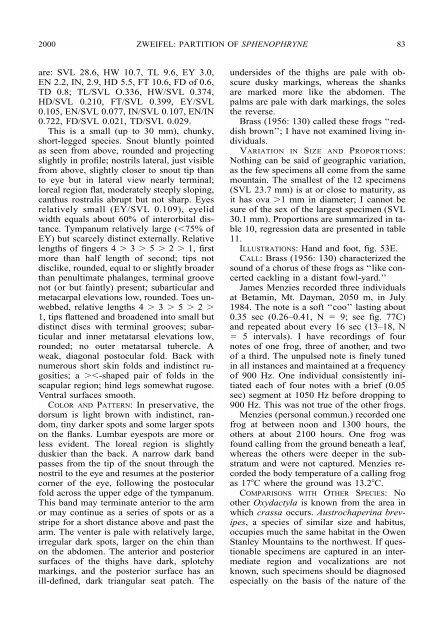SPHENOPHRYNE - American Museum of Natural History
SPHENOPHRYNE - American Museum of Natural History
SPHENOPHRYNE - American Museum of Natural History
You also want an ePaper? Increase the reach of your titles
YUMPU automatically turns print PDFs into web optimized ePapers that Google loves.
2000 ZWEIFEL: PARTITION OF <strong>SPHENOPHRYNE</strong><br />
83<br />
are: SVL 28.6, HW 10.7, TL 9.6, EY 3.0,<br />
EN 2.2, IN, 2.9, HD 5.5, FT 10.6, FD <strong>of</strong> 0.6,<br />
TD 0.8; TL/SVL O.336, HW/SVL 0.374,<br />
HD/SVL 0.210, FT/SVL 0.399, EY/SVL<br />
0.105, EN/SVL 0.077, IN/SVL 0.107, EN/IN<br />
0.722, FD/SVL 0.021, TD/SVL 0.029.<br />
This is a small (up to 30 mm), chunky,<br />
short-legged species. Snout bluntly pointed<br />
as seen from above, rounded and projecting<br />
slightly in pr<strong>of</strong>ile; nostrils lateral, just visible<br />
from above, slightly closer to snout tip than<br />
to eye but in lateral view nearly terminal;<br />
loreal region flat, moderately steeply sloping,<br />
canthus rostralis abrupt but not sharp. Eyes<br />
relatively small (EY/SVL 0.109), eyelid<br />
width equals about 60% <strong>of</strong> interorbital distance.<br />
Tympanum relatively large (75% <strong>of</strong><br />
EY) but scarcely distinct externally. Relative<br />
lengths <strong>of</strong> fingers 4 3 5 2 1, first<br />
more than half length <strong>of</strong> second; tips not<br />
disclike, rounded, equal to or slightly broader<br />
than penultimate phalanges, terminal groove<br />
not (or but faintly) present; subarticular and<br />
metacarpal elevations low, rounded. Toes unwebbed,<br />
relative lengths 4 3 5 2 <br />
1, tips flattened and broadened into small but<br />
distinct discs with terminal grooves; subarticular<br />
and inner metatarsal elevations low,<br />
rounded; no outer metatarsal tubercle. A<br />
weak, diagonal postocular fold. Back with<br />
numerous short skin folds and indistinct rugosities;<br />
a -shaped pair <strong>of</strong> folds in the<br />
scapular region; hind legs somewhat rugose.<br />
Ventral surfaces smooth.<br />
COLOR AND PATTERN: In preservative, the<br />
dorsum is light brown with indistinct, random,<br />
tiny darker spots and some larger spots<br />
on the flanks. Lumbar eyespots are more or<br />
less evident. The loreal region is slightly<br />
duskier than the back. A narrow dark band<br />
passes from the tip <strong>of</strong> the snout through the<br />
nostril to the eye and resumes at the posterior<br />
corner <strong>of</strong> the eye, following the postocular<br />
fold across the upper edge <strong>of</strong> the tympanum.<br />
This band may terminate anterior to the arm<br />
or may continue as a series <strong>of</strong> spots or as a<br />
stripe for a short distance above and past the<br />
arm. The venter is pale with relatively large,<br />
irregular dark spots, larger on the chin than<br />
on the abdomen. The anterior and posterior<br />
surfaces <strong>of</strong> the thighs have dark, splotchy<br />
markings, and the posterior surface has an<br />
ill-defined, dark triangular seat patch. The<br />
undersides <strong>of</strong> the thighs are pale with obscure<br />
dusky markings, whereas the shanks<br />
are marked more like the abdomen. The<br />
palms are pale with dark markings, the soles<br />
the reverse.<br />
Brass (1956: 130) called these frogs ‘‘reddish<br />
brown’’; I have not examined living individuals.<br />
VARIATION IN SIZE AND PROPORTIONS:<br />
Nothing can be said <strong>of</strong> geographic variation,<br />
as the few specimens all come from the same<br />
mountain. The smallest <strong>of</strong> the 12 specimens<br />
(SVL 23.7 mm) is at or close to maturity, as<br />
it has ova 1 mm in diameter; I cannot be<br />
sure <strong>of</strong> the sex <strong>of</strong> the largest specimen (SVL<br />
30.1 mm). Proportions are summarized in table<br />
10, regression data are presented in table<br />
11.<br />
ILLUSTRATIONS: Hand and foot, fig. 53E.<br />
CALL: Brass (1956: 130) characterized the<br />
sound <strong>of</strong> a chorus <strong>of</strong> these frogs as ‘‘like concerted<br />
cackling in a distant fowl-yard.’’<br />
James Menzies recorded three individuals<br />
at Betamin, Mt. Dayman, 2050 m, in July<br />
1984. The note is a s<strong>of</strong>t ‘‘coo’’ lasting about<br />
0.35 sec (0.26–0.41, N 9; see fig. 77C)<br />
and repeated about every 16 sec (13–18, N<br />
5 intervals). I have recordings <strong>of</strong> four<br />
notes <strong>of</strong> one frog, three <strong>of</strong> another, and two<br />
<strong>of</strong> a third. The unpulsed note is finely tuned<br />
in all instances and maintained at a frequency<br />
<strong>of</strong> 900 Hz. One individual consistently initiated<br />
each <strong>of</strong> four notes with a brief (0.05<br />
sec) segment at 1050 Hz before dropping to<br />
900 Hz. This was not true <strong>of</strong> the other frogs.<br />
Menzies (personal commun.) recorded one<br />
frog at between noon and 1300 hours, the<br />
others at about 2100 hours. One frog was<br />
found calling from the ground beneath a leaf,<br />
whereas the others were deeper in the substratum<br />
and were not captured. Menzies recorded<br />
the body temperature <strong>of</strong> a calling frog<br />
as 17C where the ground was 13.2C.<br />
COMPARISONS WITH OTHER SPECIES: No<br />
other Oxydactyla is known from the area in<br />
which crassa occurs. Austrochaperina brevipes,<br />
a species <strong>of</strong> similar size and habitus,<br />
occupies much the same habitat in the Owen<br />
Stanley Mountains to the northwest. If questionable<br />
specimens are captured in an intermediate<br />
region and vocalizations are not<br />
known, such specimens should be diagnosed<br />
especially on the basis <strong>of</strong> the nature <strong>of</strong> the
















